学部・大学院FACULTY TAISHO
国際文化コース
ケヴィンのインターン報告⑦
ケヴィンの大正大学でのインターン生としての活動をブログで報告してきましたが、今回の記事は英語です。
日本に来て、英語で文章を書く機会のなかったケヴィンにとって、久しぶりの英語のエッセイです。
ケヴィンはThe Goldstein Internships in Japanで日本に来ていますが、そのなかのもう一つのプログラムであるO.G.A FOR AID(http://www.ogaforaid.org/jp/index.html)にも参加して、南三陸でのボランティア活動をしてきました。今回の記事は、その報告です。
大正大学も東北大震災の発生直後から、さまざまな支援活動を行っています。大正大学の学生たちも、たくさんのことを東北で学んでいます。助けることは助けられること、励ますことは励まされること、東北に行った学生たちは口をそろえて、自分のほうが力をもらった、と言います。
もうすぐ5年目の3月11日です。
●●●
Hi everyone. This blog post will be in English! It’s always nice to change things up every once in a while. I hope you enjoy it.
Two weeks ago, I had the honor of travelling to Minamisanriku (in Miyagi Prefecture) and spending the weekend there doing volunteer work. Minamisanriku was greatly affected by the 3.11 disaster. 95% of the town was destroyed, and countless lives were lost that day. Even today, thousands of people are displaced and live in temporary shelters. The town still has a long way to go in terms of recovery. The work I did was through an organization called O.G.A. for Aid, whose goal is to create “a world where survivors are inspired and connected at all stages of the recovery process.” My job while I was there was to work on a green onion farm.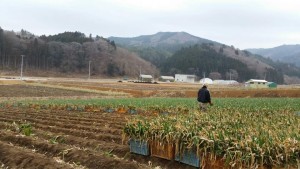
My stay there was brief. Yet, I learned a few things. Life on a farm is much more difficult than the rustic images I’m sure many people hold in their heads. As a culture, we—at least Americans—have a tendency to put farming on a nostalgic pedestal. We romanticize the perceived simple, laidback life. However, the farming is neither simple nor laidback.
There is always something to do on a farm; it’s a busy life. Crops don’t take a break on Sunday, and neither do the farmers. Constantly, there is work that needs to be done, and most of it isn’t easy. During my time there, I cut onions, cleaned up an old greenhouse, and moved fertilizer around.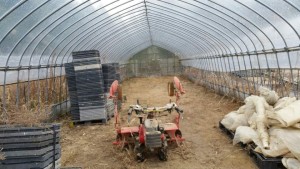
During lunch and dinner, talking to the residents of Minamisanriku, I learned about many other things. Farmers are often on the short end of the stick in business. They are taken advantage of and countless middlemen dig into any profits. While I was there, we had fix 50 boxes (10+ kg each) worth of green onions because the company that the farm sells it to said that they were “too soft.” This meant that we had to take back all the onions that we had already sent and recut the softer ends off of all the onions. The farmers was not paid for the extra time spent working on the onions, and cutting off the ends cut profit even further because they are paid based on weight. Sometimes, these things don’t seem fair, but often, there is no choice but to deal with it.
Another problem I learned that the community is facing is a more general one. The government provides a lot of assistance to the people of Minamisanriku, but it is usually to only the people directly affected by the disaster. Yet, the people whose homes weren’t destroyed also suffer. They also have no supermarkets to go to, and their access to basic goods are also limited. However, they don’t get all the help that they need. Moreover, although I’m not too certain about the details, there seems to be many businesses in the area that try to take advantage of the disaster and victims to make a quick profit.
On a more positive note, it was fantastic to see everything being done in the community. The farm I worked at is run by volunteers that came after the disaster who knew nothing about agriculture beforehand. Over the past few years, what OGA for Aid (working with local residents) has done for the area is quite amazing, and although I never visited Minamisanriku in the first 5 years after the tsunami, it was great to see the community slowly rebuilding itself. The photo below shows construction and some of the many giant piles of dirt being trucked into the town. They’re attempting to raise the elevation of the area so that if another tsunami occurs, the damage won’t be as bad as it was in 2011.
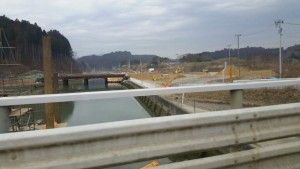
Another thing that left a large impact on me was hearing stories from the day of the disaster. The building shown in the photo below is the Crisis Management Department’s building. I actually remember seeing a picture of this building 5 years ago and learning about it. The story I reheard was just as powerful the second time as when I first heard it all those years ago. Miki Endo was a 25-year old woman employed there, and her job was to voice warnings and disaster advisories to the town. On the day of the tsunami, she sacrificed her life by continuously sending warnings and alerts over the loudspeaker to the community. She did this until the tsunami swept through the building. Out of all the people that were in the building, less than a dozen survived. Miki Endo died that day, but became a hero.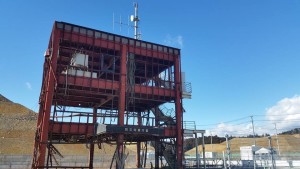
Another tragedy was that the time between the earthquake and the first wave was about half an hour. Ironically, that time frame was both too short and too long at the same time. Some people didn’t have enough time to escape, while other people thought that they might have time to go back and grab something from their homes. They were, unfortunately, mistaken. A really crushing story I heard is about one guy who was escaping from a nursing home. As he was escaping, he realized he could carry only one of the elderly residents out with him and had to choose. He had to leave everyone else behind. How do you even begin to make a decision like that? I can’t fathom what it’s like to go through something like that, especially if they were all people I knew.
The impact that I personally left behind may be miniscule. Just one weekend in Minamisanriku probably didn’t accomplish much. Yet, I’m glad that I had the opportunity to visit and do some volunteer work. It was a humanizing experience. Hearing all those stories and working in the fields makes one reflect about life. The overall tone of this blog post may seem negative. However, I’d like to make a point that the story of Minamisanriku isn’t all about tragedy. It’s also tale of recovery, bravery, and hope. Many people suffered a great deal, but now, they’re doing their best to bounce right back up. Minamisanriku has been home to many for a long time, and they’re doing their best to keep it that way. All the volunteers and community members up there working to help those in need are great men and women. They have my utter respect.
————————–
The day I left Minamisanriku, I woke up early. When I looked out the window, I saw a sunrise. The sky bled into the ocean, and the colors were both delicate and elegant. I heard that when the sun rose the day after the earthquake, for many, it was the most beautiful sunrise they had ever seen in their lives. I think I can understand why.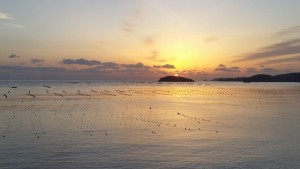
●●●
写真で見ても、心が洗われるような荘厳さが伝わってきます。
新しい日、新しい希望を信じて、心からの祈りを捧げます。
♪伊藤淑子
